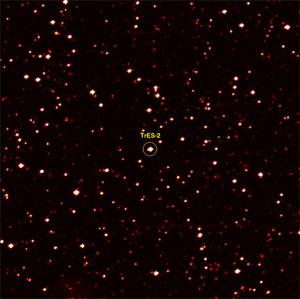Astronomers have discovered the darkest known exoplanet, according to a report released by the Harvard-Smithsonian Center for Astrophysics (CfA) on Friday.

At the center of this image is a star with a known "hot Jupiter" extrasolar planet, TrES-2b, orbiting around it every 2.5 days. The area pictured is one-thousandth of Kepler's full field of view, and shows hundreds of stars of the constellation Draco. The image has been color-coded so that brighter stars appear white, and fainter stars, red. It is a 60-second exposure, taken one day after the spacecraft's dust cover was jettisoned. Celestial north is to the left. (Photo
The CfA report said that a distant, Jupiter-sized gas giant known as TrES-2b is blacker than coal or any planet or moon in our solar system, as it only reflects less than one percent of the sunlight falling on it. More than a third of the sunlight reaching planet Jupiter in our solar system is reflected in bright clouds of ammonia. However, TrES-2b, which was discovered in 2006 by the Trans-Atlantic Exoplanet Survey, lacks reflective clouds due to its high temperature, the report explained.
“TrES-2b is considerably less reflective than black acrylic paint, so it’s truly an alien world,” said astronomer David Kipping of CfA, who is also the lead author on the paper reporting the research.
Co-author David Spiegel of Princeton University, meanwhile, noted that it was not completely pitch black, explaining that it is so hot that it emits a faint red glow, much like a burning ember or the coils on an electric stove.
The exoplanet’s particular atmosphere contains light-absorbing chemicals like vaporized sodium and potassium, or gaseous titanium oxide. However, Spiegel said it was still not clear why the planet is as dark as it is, as none of these chemicals fully explain the extreme blackness of TrES-2b.
TrES-2b orbits its star at a distance of only three million miles (4.8 million kilometers), and the star’s intense light heats TrES-2b to a temperature of more than 1,800 degrees Fahrenheit (982 degrees Celsius), which is much too hot for ammonia clouds, the report explained.
Kipping and Spiegel determined the reflectivity of TrES-2b using data from NASA’s Kepler spacecraft, which is designed to measure the brightness of distant stars with extreme precision. The team monitored the brightness of the TrES-2 system as the planet orbited its star. They detected a subtle dimming and brightening due to the planet’s changing phase.
TrES-2b orbits the star GSC 03549-02811, which is located about 750 light-years away in the direction of the constellation Draco. (One light-year is about 6 trillion miles (9.6 trillion kilometers).







